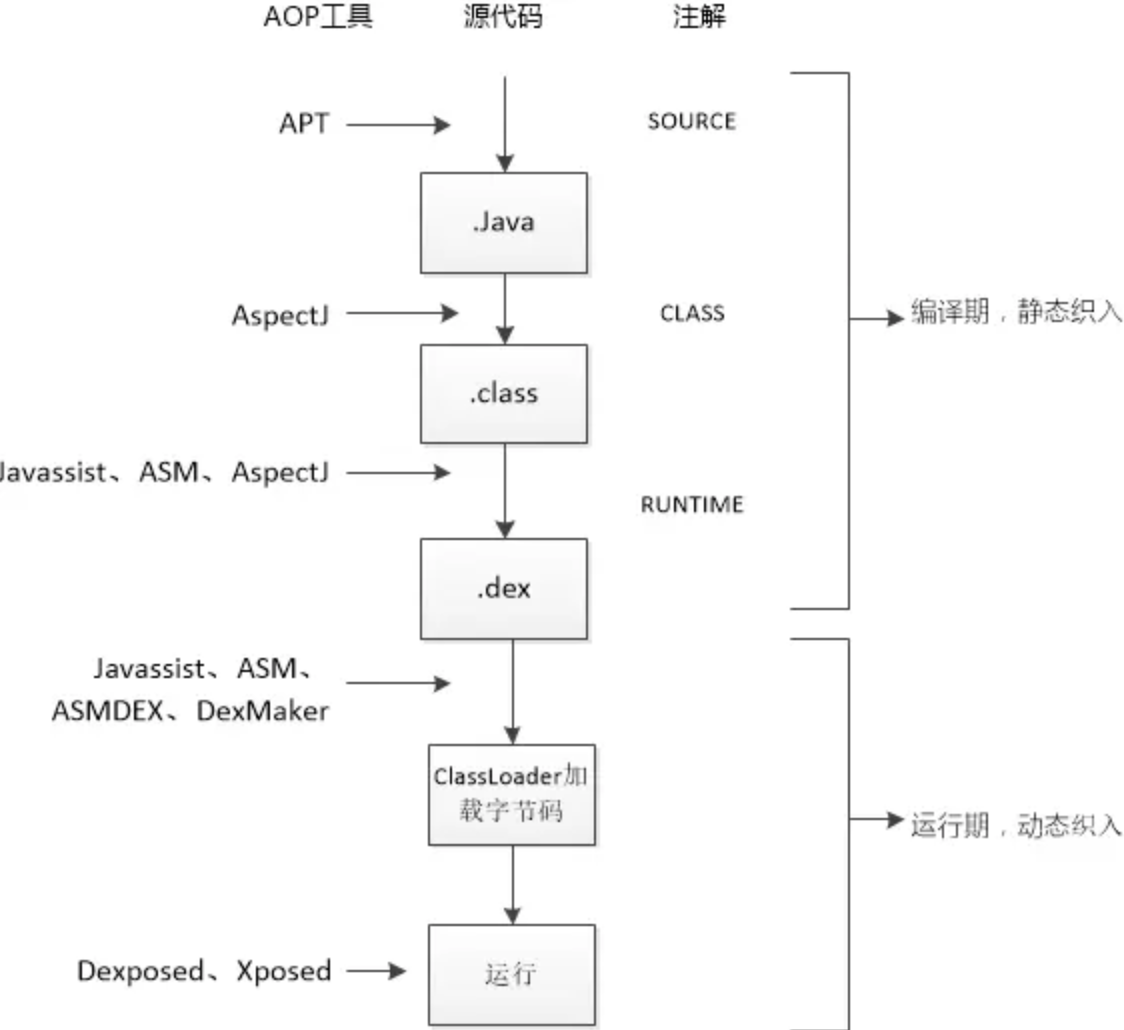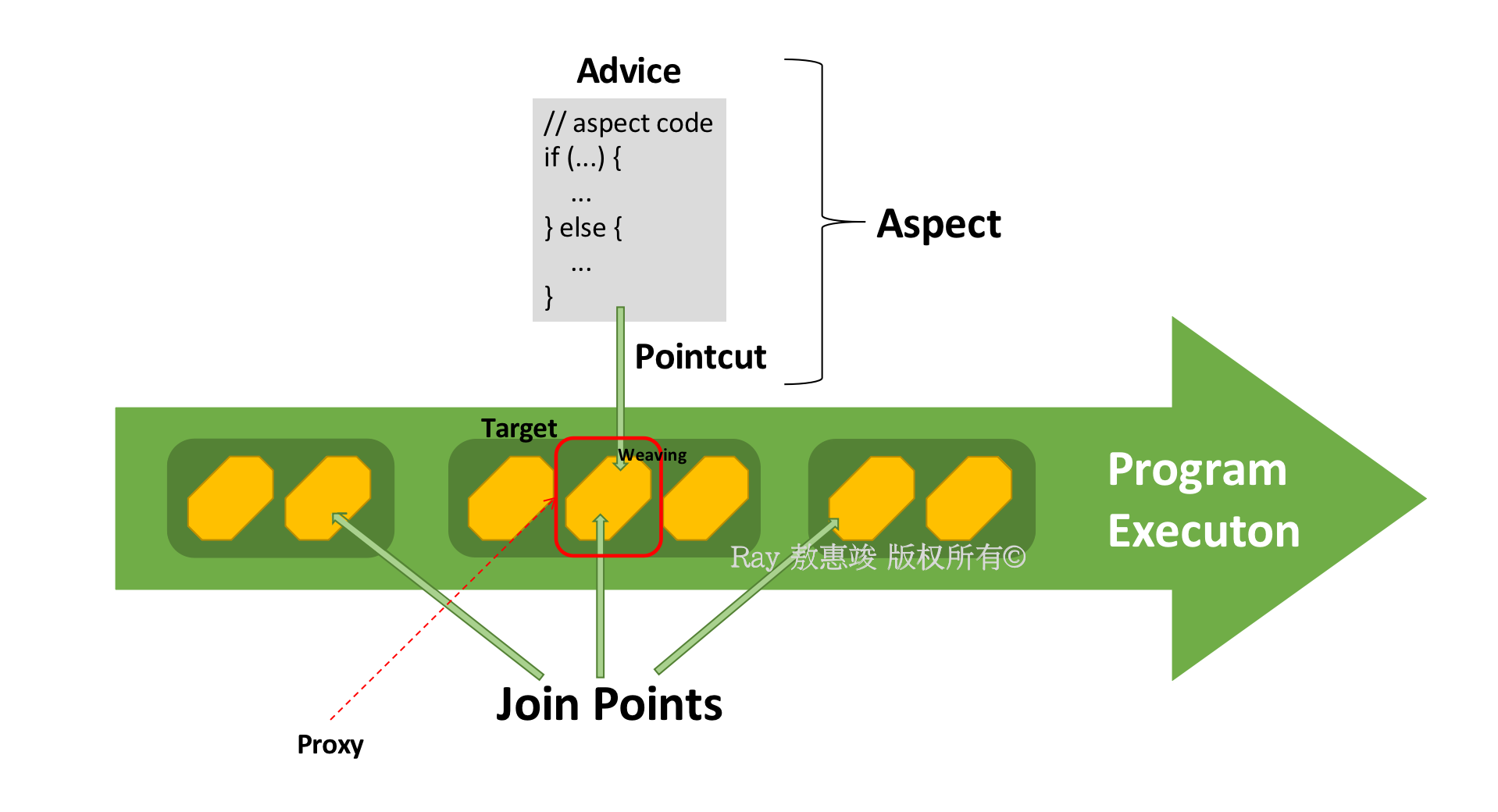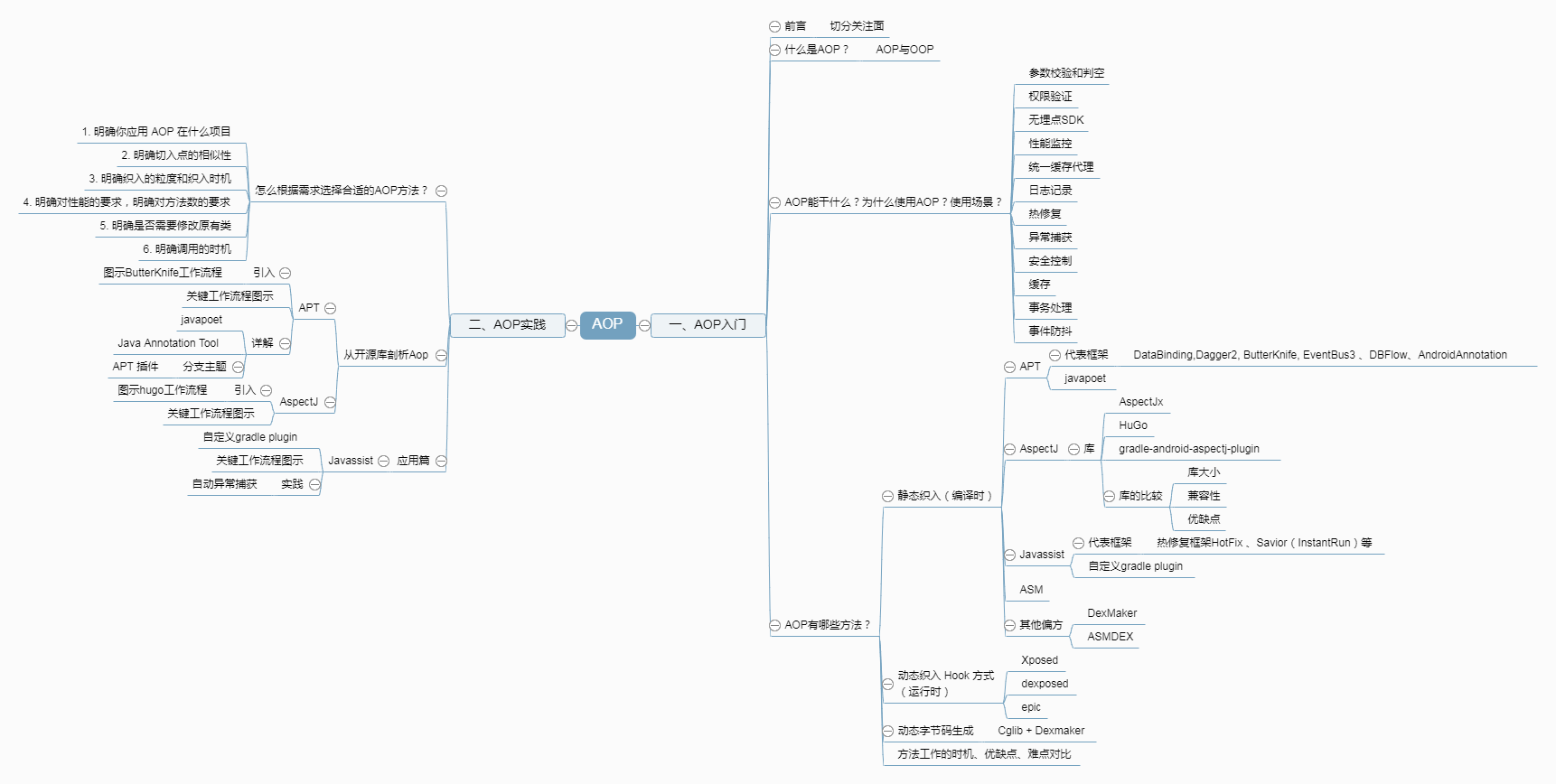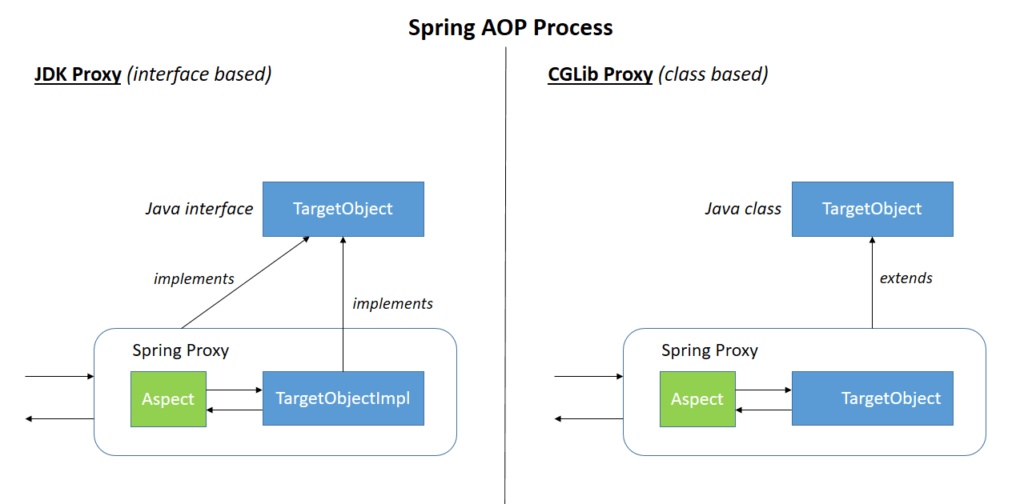同样,AOP 不仅仅是针对 Spring 才能应用的逻辑。
AOP 概述
我们知道,OOP 可以提供复杂而纵深的继承体系,但是对于一些非继承关系的横向加强功能并不容易实现。
比如,当很多其它的类的方法都调用某一个类的成员方法时,需要这些类都持有该类的对象,且这些类的所有对象都需要显式地依赖该对象。
举个例子:
1 | public class A { |
A 和 B 两个类中的 doSth() 部分代码几乎是完全重复的,而且与其业务并不相关联。
有的时候虽然这种代码并不多,但是业务类膨胀了之后,万一都需要用到这一段逻辑,反复添加这种与业务不相关的代码也是一件比较烦的事。
能否用某种方式实现同样功能,而不需要开发者写重复的代码逻辑?
由此,我们提出了 Aspect-Oriented Programming,面向切面编程的概念,是一种对 OOP 纵向结构丰富而横向结构缺失的补充。
在 AOP 思想中,应用的功能分为两类:
- 核心业务(核心关注点),如登陆、增加数据、删除数据
- 周边功能(横切关注点),如性能统计、日志、事务管理等
周边功能,或者说非核心功能在 AOP 中被定义为切面;核心业务功能与切面功能分别独立开发,然后“编织”到一起,就是 AOP。
AOP 实现基础
AOP 的实现主要有两个方向:
- 使用特殊的编译器,将这些功能代码在编译阶段“织入”源代码,运行时代码会被切入到类的指定方法、指定位置。
- 利用动态代理在运行时将这些功能代码切入。
动态代理能够解决静态代理中代理类接口过多的问题。Java 提供了两种动态代理的方法:
JDK 代理
- 通过反射接收被代理的类
- 被代理的目标类需要实现一个接口(业务相关的接口),没有在该接口定义的方法不能被代理
- Spring AOP 默认采用此方式进行代理
- 只有被代理的类没有实现接口时:才会被切换到 CGLib 代理
CGLib(Code Generation Library)代理
一个强大的高性能的代码生成包,底层使用一个小而快的字节码处理框架 ASM
- 需要 CGLib 支持,
Enhancer是 CGLib 的字节码增强器,可以很方便的对类进行拓展 - 相当于运行时扩展 Java 类与实现 Java 接口,动态创建一个被代理的类的非继承子类(组合)
- 也称为子类代理
- final 类无法使用 CGLib 作为动态代理
不同的 AOP 工具以及它们对应的织入时机如下:

AOP 相关概念
既然是“面向切面编程”,我们先来聊聊“切面”。
切面(Aspect)是一个总的概念,阐述的是在什么时候(When),什么地方(Where)执行什么样的代码(What)。
切面由以下几个概念点组成:
1. 增强 Advice
Advice 定义了切面当中的方法,以及声明了 Advice 方法在目标(Target)业务层的执行位置。
也就是说,Advice 定义好了 What(切入后进行的行为)和 When(切面切入时机)。
比如上例中的 TheOne.doSth() 就可以看作是一个可增强的点(Advice),它在类 A 和 B 里面执行的时机就是 “When”。
针对一个 Advice 方法(What),合理的切入时机(When)包括:
@Before: 前置通知,方法调用前@After: 后置通知,方法执行后,不考虑返回@AfterReturning: 返回通知,方法返回后@AfterThrowing: 异常通知,方法抛出异常后@Around: 环绕通知,方法前以及方法后
上述的切入时机叫做连接点 Join Point,属于程序(业务流)中的概念,说明在业务流中可以对哪些方法进行拦截,拦截后怎么处理。
具体到代码中的话,可以将 Join Point 理解为目标对象中的具体方法。
2. 切入点 Pointcut
切入点定义了 Where,即选择在某一个确定的连接点 Join Point —— 确定在哪些类、哪些方法上进行切入。
在确定切入点的时候,允许定义具体的方法名、类名,或者使用正则匹配等方法。
因此连接点 Join Points 指的是程序执行流中所有可以被选择做增强的点;而切入点 Pointcut 指的是从所有可以的 Join Points 中确定具体要拦截的某个业务点。
在 Advice 与 Pointcut 配合下,切面就成型了。程序就知道切入的 When、Where 和 What,即什么时机,什么地方做什么样的增强。

除了切面的概念之外,其它概念包括:
织入 Weaving
织入指的是根据切面的定义,将相应的 advice 加入到切面 pointcut 指定的 join points,并创造出代理对象的过程。
织入由代理完成。
目标对象 Target
被一个或多个切面增强的对象,因此也被称为“被增强对象”。它永远是一个被代理对象。
引入 Introduction
相对于切面只是针对指定方向的增强,引入可以针对类进行增强,为其动态添加新的方法或域。
常见应用
- 权限控制(鉴权)
- 日志
- 参数校验
- 缓存、调试、性能检测
- 一定程度的事务处理
- …
应用 AOP 的目的:
- 将与业务无关,却为业务所共同调用的逻辑或责任(事务处理、日志管理、鉴权、…)封装起来
- 可以集中处理某一关注点/横切逻辑,并且很方便地添加/删除关注点
- 便于减少系统重复代码,降低模块间耦合度,利于可拓展性和可维护性
在别处找了一个 AOP 的思维导图参考一下:

Spring AOP
Spring AOP 使用纯 Java 实现,不需要专门的编译过程和类加载器。
实现原理:运行时通过代理方式向目标类织入增强代码。
主要的实现方向有两个:
- 接口 + 实现类:采用 JDK 动态代理 Proxy
- 仅实现类:使用 CGLib 字节码增强

选择
- 如果目标对象实现了接口,默认情况下会采用 JDK 的动态代理实现 AOP。
- 如果目标对象实现了接口,可以强制使用 CGLib 实现 AOP。
- 如果目标对象没有实现了接口,必须采用 CGLib 库,Spring 会自动在 JDK 动态代理和 CGLib 之间转换。
区别
JDK 动态代理:通过接口实现
- 通过继承
InvocationHanlder实现拦截器,结合反射机制实现一个代理接口 - 再通过
Proxy.newProxyInstance()方法,由传入的 classloader 生成接口代理类的字节码文件 - 根据字节码文件创建代理类的实例对象
- 只能对实现了接口的类生成代理,否则抛出异常
CGLib:通过继承覆盖
- 利用 ASM 开源包,加载被代理对象(真实对象)类的
.class文件,通过修改其字节码生成子类 - 主要是对指定的类生成一个子类,覆盖其中的方法,并覆盖其中方法实现增强
- 因为采用的是继承,对于 final 类或方法,是无法起效果的
Spring 2.0+ 之后引入了对 AspectJ 的支持。
Spring AOP 和 AspectJ 两种 AOP 方向的比较:
| Spring AOP | AspectJ |
|---|---|
| 纯 Java 实现 | 使用 Java 语言的扩展实现 |
| 不需要单独的编译过程 | 除非设置 LTW,否则需要 AspectJ 编译器(ajc) |
| 只能使用运行时织入 | 运行时织入不可用。 支持编译时、编译后和加载时织入 |
| 功能不强:只支持方法级织入 | 更强大:可编织字段、方法、构造函数、静态初始值设定项、final 类/方法等 |
| 只能在由 Spring 容器管理的 bean 上实现 | 可在所有域对象上实现 |
| 仅支持方法执行切入点 | 支持所有织入点 |
| 代理是由目标对象创建的,并且切面应用在这些代理上 | 执行应用程序(运行时)前,各方面直接在代码中进行织入 |
| 比 AspectJ 慢多了 | 更好的性能 |
| 易于学习和应用 | 相对于 Spring AOP 更复杂 |
下面说一下几种不同的 AOP 实现方式:
手动方式(原理代码)
下面基于 Spring AOP 实现原理手动实现 JDK 动态代理和 CGLib 两种方式的 AOP,这是没有 Spring 侵入的实现方式。
现有目标类 Target:
1 | public interface UserService { |
和切面类 Aspect:
1 | public class MyAspect { // 该切面类属于环绕通知 |
1. JDK 动态代理。要求目标类为接口 + 实现类
1 | import java.lang.reflect.InvocationHandler; |
2. CGLib 字节码增强:只有实现类
1 | import org.springframework.cglib.proxy.Enhancer; // CGLib 实现核心 |
注:MethodInterceptor.intercept() 能够代理某个对象所有非 final 方法的调用。
因此 getClass(), wait() 等 final 方法不能被代理。
半自动
利用切面实现介入器 MethodInterceptor,并从 Spring 容器手动获取代理对象。
1 | import org.springframework.cglib.proxy.MethodInterceptor; |
配置文件如下:1
2
3
4
5
6
7
8
9
10
11
12
13
14
15
16
17
18
19
20
21
22
23
24
25
26
27
28
29<!-- encoding... -->
<beans ...>
<!-- 目标类 -->
<bean id="userService" class="com.example.UserServiceImpl"/>
<!-- 切面类 -->
<bean id="myAspect" class="com.example.MyAspect"/>
<!-- 创建代理类
* 通过工厂 bean ProxyFactoryBean 创建,底层调用 getObject() 返回特殊代理对象
- interfaces:确定接口
通过<array>可以设置多个值
只有一个值:value=""
- target:确定目标类
- interceptorNames:增强切面类的名称
- optimize:强制使用 CGLib
<property name="optimize" value="true"/>
* ProxyFactoryBean 的底层机制
- 如目标有接口:采用 JDK 动态代理
- 如没有接口:采用 CGLib 字节码增强
- 如声明 optimize=true:强制使用 CGLib
-->
<bean id="proxyService" class="org.springframework.aop.framework.ProxyFactoryBean">
<property name="interfaces" value="com.example.UserService"/>
<property name="target" ref="userService"/>
<property name="interceptorNames" value="myAspect"/> <!-- 定义切面 -->
</bean>
</beans>
MyAspect 的 AOP 在以下的调用中就能实现:
1 | // 调用: |
全自动
大体的步骤如下:
- 从 Spring 容器获得目标类(target)
- 通过配置文件配置 AOP
- Spring 自动生成代理
配置文件:
1 | <!-- encoding... --> |
另外还需要在 CLASSPATH 使用相关 AspectJ 库文件。
AOP 切面声明参考:
1 | <beans ...> |
使用的时候就可以:
1 | <beans ...> |
这样就免掉了 AOP 的 Java 代码。
基于 AOP 的 AspectJ:注解配置 AOP
需要在配置文件中添加这么一行:
1 | <!-- 新增如下配置: --> |
工程中再声明一个增强:
1 | import org.aspectj.lang.annotation.Aspect; |
标记好注解之后,在配置文件只需要添加 aspect bean 的定义即可。
声明参考:
1 |
|
Spring AspectJ 是通过 AnnotationAwareAspectJAutoProxyCreator 实现的。
其本质上是一个 BeanPostProcessor,父类为 AbstractAutoProxyCreator。
给一个类中的某个方法设置了切面之后,这个类最终需要生成一个代理对象,再放进 bean 缓存池中。